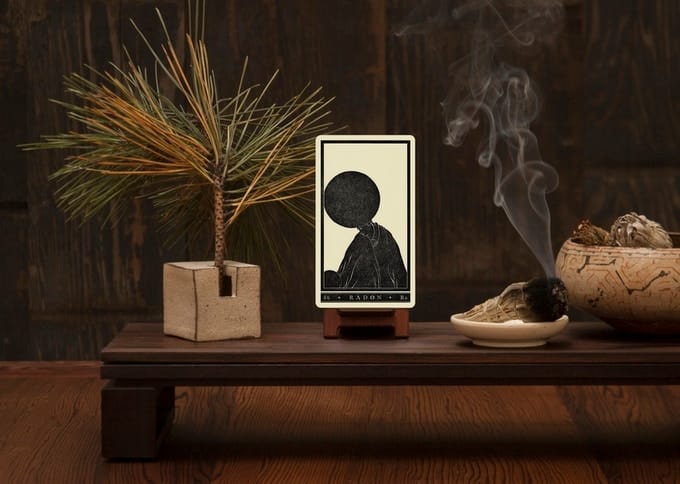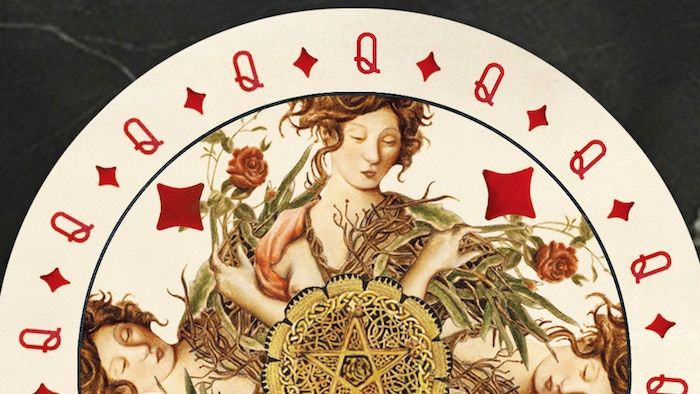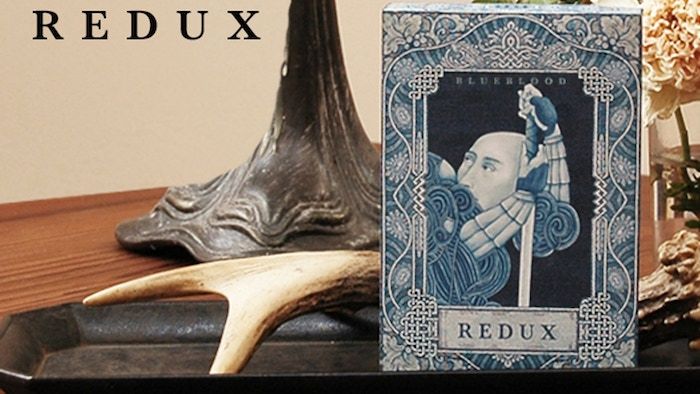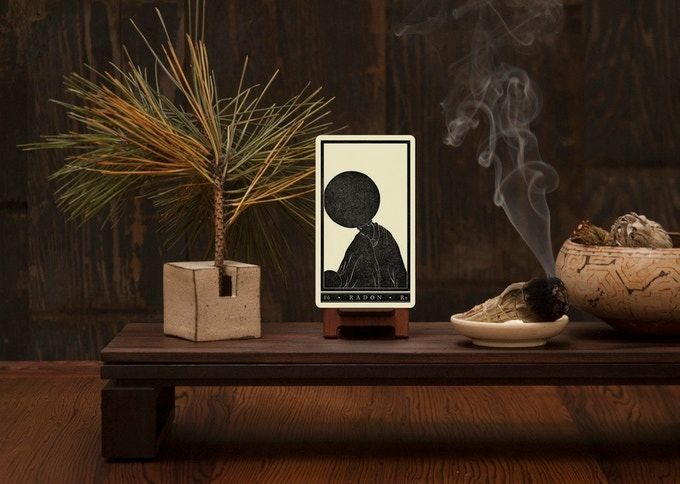Uusi's Secrets for Kickstarter Success
Linnea Gits of the Uusi design studio shares her Kickstarter story and pays it forward with tips for aspiring creators.

Uusi is a design studio founded and led by designers/artists Linnea Gits and Peter Dunham. The duo creates work in a wide variety of mediums and has successfully funded 13 tarot and playing card projects on Kickstarter, including Materia Prima, a deck based on the periodic table; and a limited-run tarot called Eros, which celebrates erotic love. Here, Gits shares the story of how she and Dunham began using Kickstarter to make their creative ideas to come to life, and offers a series of practical pointers for people interested in running their own campaigns.

Our Intro to Kickstarter
I vividly remember the first time I heard about Kickstarter. It was the fall of 2011, and I was catching up with an old friend over a few drinks at a taco bar in Chicago. It was a late, hot afternoon, and I was happy to be in good company, laughing over a cold beer and not stressing out about my life at home. A year earlier, my husband, Peter Dunham, and I had started a design studio called Uusi, and the enormity of that endeavor weighed on both of us. How were we going to fund all of the initial startup costs? How were we going to create interest in our work within and outside our hometown? And of course, always the nagging concern–how were we going to continue paying the rent on our studio space? My entire life had turned risky, unstable, and overwhelming. But at that moment, on that day, I just wanted to relax and step out of the endlessly looping cycle of fear that had become my constant state of mind.
As we were laughing and commiserating at the bar, a woman I’d met while working on a design project a few years before walked up to us and congratulated me on the launch of Uusi. She had read a small article that a local magazine had written about our new company and thought it was great that we were striking out on our own. I thanked her and asked her what she was currently working on. “Oh, I’ve been working over at the Minimal design studio with Scott Wilson, and we just finished a Kickstarter for a watch design that raised close to a million dollars in one month. It was crazy!” I had been listening politely at first, but as she finished that sentence, this wondrous woman suddenly had my complete and total attention.
But I was confused. “What is Kickstarter?” I said, “And how did it raise almost a million dollars in a month?” The sounds of the busy restaurant faded. As she told the story of Scott Wilson’s success on the awesomeness of Kickstarter’s platform, I felt my heart racing in my chest. Here was the answer I’d been looking for! This was how we would get the word out about our studio. I don’t remember anything else about that meal except that I couldn’t wait for it to be over so I could go home and look up Kickstarter and find out everything about it.
Taking the Plunge
Fast forward to the spring of 2012. I’d researched everything I could about this seemingly magical funding platform. I scrolled through hundreds of projects and read whatever articles I could find about the company. But after a few months of investigating, my enthusiasm began to wane. The platform seemed hugely intimidating, and the real success stories seemed to be glossy, high-production tech gadgets like Scott Wilson’s watch. Would a project based on traditional art techniques find an audience? How would we get the word out about it? How would we create content that inspired Backers to join our project and see it through to completion? And what were rewards really? This and hundreds of other questions and insecurities about using Kickstarter slowly ate away at my initial, fearless energy.
And then something extraordinary, then quickly terrible, happened. A prestigious design retailer, Design Within Reach, approached us. Very soon, we quickly got in over our heads with a small production run of wood animal sets we had just released and that they wanted for their holiday catalog. At the time, we were too small of a company to handle working with a retailer of that size, and the staggering, unforeseen, upfront cost involved in producing their order out of our own pocket crushed us. Somehow, we completed the work, but it came at the expense of our business’s solvency.
With no cash flow and debt piling up (thank god our landlord was on a six-month cruise and his saint of a secretary kept our missed payments a secret, saying she knew we would make good somehow), we once again revisited the idea of running a Kickstarter. A few years before we launched our design studio, Peter and I had created a playing card deck for a large tequila brand. After choosing the direction they wanted from the three styles we presented, the artwork for the other two styles was archived in a flat-file at our studio. We pulled those sketches out again and thought, “Why not launch a playing card deck?” We especially loved one of the design directions we’d created and we loved the playing card format. It felt like a natural and enjoyable choice for our art and design studio.

The Magic of Connecting with Community
And so, with next to no understanding of the playing card world, other than that we thought it would be cool to see an entirely hand-drawn deck in the modern market, we launched our first Kickstarter with a deck called Blueblood. We put our story together, begged a friend who was a video editor to help us with our little homemade movie, and did the best we could to come up with enticing rewards. We still only had a vague idea of how Kickstarter worked. We did not have any experience in mass shipping. We had just come off of a very unhappy experience with large-scale production and manufacturing timelines where we had grappled with keeping our vendor’s production quality up to our standards and with all of the shipping logistics on a bulk quantity order with a large corporation. We were pretty much still newbies at this whole realm of mass production, gripping onto its oversized steering wheel, trying to stay on the road ahead. Were we ready for Kickstarter?
The truth is, we didn’t think it would succeed. After carefully putting our project together, we then let it sit in the queue, suddenly insecure about it, and focused on what we thought were more conventional, reliable avenues of work. And then, on a trip to LA to visit my sister, sitting in her living room one morning while she was at work, feeling like my dream of having our design studio was quickly disappearing, I pulled our Kickstarter project up on my laptop and thought, “Why not?” I called Pete, and he said, “Just launch it.” So I did. On my sister’s sofa in LA, I released our little playing card project into the Kickstarter realm. And about two minutes later, we had a Backer. Then another, and another. I was floored. We hadn’t even sent out an email to our friends, work contacts, and family yet, so who were these incredible people?
That day we suddenly understood what Kickstarter was about. Kickstarter is a global community of very active and curious people with all sorts of creative objects and ideas to share and support. It was not just tech-based; it was discovery-based. And within the Kickstarter community was a thriving, growing, and passionate group of playing card collectors who were hungry for innovation and deeply appreciative and educated about the objects of their desire. Who knew? We sure didn’t. But we were soon to discover, understand, and love this distinctive group. Like almost all Backers on Kickstarter, they were true collaborators there to help form and support the creative effort being put forward on a project they valued and believed in. It felt magical. Not fairy-tale magic of “Bing! You are now rich!” More the kind of everyday magic that opens you up, restores hope, and lets the world flow through you with powerful, regenerative connectivity.
It’s been nine years since that first successful Kickstarter launch, and in that time, we have created 13 successfully funded Kickstarter projects, most of which funded way beyond our goals. We learned some humbling experiences throughout this time, enjoyed some incredible successes, and built a design studio with a global presence. Because of this international success, we were able to capture the attention of and be prepared to work with other international companies like the art and design publisher Taschen, the prestigious MIT Library’s Distinctive Collections division, and the elite fashion house Louis Vuitton, to name just a few. None of this would have been possible without the support of the Kickstarter community, whose invaluable education and shared ideas generously connected us to the people who believed in and supported our work and made a future for our design studio possible. Viva Kickstarter!
We are happy to share some of the incredible lessons taught to us by the global community we love so dearly and to pay it forward, as all our favorite visionaries in the world have shown us how to do.

Uusi's Kickstarter Lessons
Create something you believe in. If you don’t love what you are making, no one else will, and you definitely won’t be able to talk about it with any conviction.
Pay attention to the visual details. It matters what your project page looks like. This isn’t to say you have to spend a fortune on a glossy video production and professional photography, but whatever you are doing, be sure to spend the time to make it look and feel unique–like you.
Tell your story. Do not be afraid to write. We are born storytellers, and we all love a good tale well told. It doesn’t have to be a novel–no one has the time for that when making a first impression–but it should give a complete stranger a sense of who you are and a good reason to stick around. This goes for the video as well, should you choose to create one. Just as crucial as the homepage are your project updates. Your backers want to hear from you as the project progresses. They want to know you are as engaged as they are, and it is a great place to further expand on what you are creating. A project with only one or two updates isn’t going to feel alive. That said, don’t overdo this feature. Try to pace them out so they have meaningful content that is enjoyable to read. Too many updates are a turn-off. Respect your Backers’ busy lives. Fast-moving projects may need more updates than others, but most projects do not need an update every other day.
Always stay at the center of your project. Spontaneity is great, but it feels more playful and less uncertain when it comes from a centered space. Stay focused on what it is you want to accomplish and don’t get carried away with too much extra bling. Trying to push your funding number up with added stuff means you are potentially making a lot more work for yourself that takes you away from the project’s main goal, brings production complications, could add significant delays, and complicates the fulfillment process financially and logistically. Some very well-funded projects have lost major amounts of money hustling to get all the gewgaws that orbited their main goal completed. By keeping your rewards tiers to a meaningful amount, you clarify what you are offering, and it relieves you and your Backers of too many choices and confusion.
Get a spell check program! Grammarly is a great one. Nothing is more embarrassing than a project filled with spelling errors and grammatical gaffes. We learned this one the hard way.
Ignore the bullies. Having launched 13 Kickstarters, we can tell you that 98% of the people out there are truly wonderful. But there are one or two folks on every project we have created who it seems have bought their pants a size too small. They want to share their misery and do so by leaving unconstructive comments and personal attacks in the public comment section. They can create some ugly moments, but it is not fair to yourself to try and engage with them. They are often beyond reason. If someone cannot find a way to be constructive and kind, they are not worth your time no matter what their concern. And the thing is, no matter how many nasty comments they leave, they are not hurting your project. Unreasonable people look and sound unreasonable. Everyone is flinching at those ugly comments. Despite the spotlight those bullies think they have, no one wants to hear from them. Occasionally one of your amazing Backers may step up and tell a bully how ridiculous they are being. This is a gift. But don’t rely on it.
You are human. You will make mistakes. Most people understand this and are willing to help you resolve or correct mistakes if you are open and honest about it. Respond to the difficult question. Do not avoid or ignore it. This is part of the Kickstarter journey. If a Backer notices something that isn’t working (and it goes beyond a personal opinion), you need to address it. Quickly. We haven’t had many of these, but on the handful of occasions someone noticed missing elements, inconsistent content, or some other design flaw, it was truly a godsend. Hard as it was to hear at the moment, it was mentioned to improve the end result and always did. Always remember your Kickstarter project is a work in progress and almost all of your Backers would rather have you get it right than get it done right now.
Do not cold call another Creator and ask them to promote your project. As much as we want to support each other, a Kickstarter campaign is rarely a good place to do this. Your Backers do not have endless money or time to throw around, nor do you. A project Creator is working on a very focused event, and it is seldom a good thing to disrupt that focus with another Creator’s content. That said, it is terrific if you can help someone out whose work you enjoy, but if a Creator hasn’t asked to share your project and doesn’t know you, don’t stalk them on their comment board, email, DMs, or Facebook page asking for a “shout out.” It’s uncomfortable and inappropriate.
Start beating the drum for your idea on your social media platform months ahead of your launch. When we launched our first Kickstarter, Instagram was not a big deal yet. And we were not Facebook people. But if we had been, we probably could have created some early excitement that would have greatly increased our audience when we launched. By our fifth Kickstarter project, we had discovered Instagram and it definitely helped to spread the word on what we were doing in an organic, ever-growing way. It is still an invaluable place to share our ideas ahead of any launch we make.
Having your Kickstarter project funded is not like winning the lottery. You are going to work hard for the money you receive. Rarely is there a lot of money left over. Most people, ourselves included, make just enough to produce and ship their rewards. If we do get over-funded, we generally pour it back into the project. We want to make our Backers as happy as possible because it makes us happy. This happiness creates a self-sustaining cycle of happiness that spreads the good news about your work to the outside world, allowing you to grow your company beyond the Kickstarter community.
If you are using an outside vendor to make your work, know a lot about who your vendor is. Know them really, really well. This is critical. Start your relationship before your project launches so you can have easy, fast communication with them. The more familiar you are with your manufacturer’s process, the more accessible they will be, which will make you and them happier, and the work they produce for you will look and perform the way you dreamed it would.
Shipping is expensive! Do not underestimate the amount of money it will take to send something out into the world, especially if you are shipping internationally. Do your homework and know how much it will cost to ship your objects wherever they are going. And remember that the more stuff you add to your project while moving along, the more the shipping costs will be. Shipping is the number one issue we struggled with early on. It really, really adds up fast.
Finally, just enjoy yourself!
